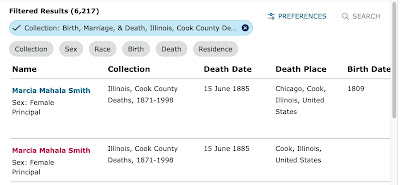 My husband's ancestor, James Ayer Smith, arrived in Chicago in the spring of 1835 with plans to open a hat and cap store, and in August of that year, his father sent him a letter with some very detailed advice on how to succeed.
My husband's ancestor, James Ayer Smith, arrived in Chicago in the spring of 1835 with plans to open a hat and cap store, and in August of that year, his father sent him a letter with some very detailed advice on how to succeed. In closing, he wrote, "There has been a heavy fire at Cleveland & I hope you will not fail to have insurance made on your stock immediately to the full amount Your affectionate Father Chas. Smith." James appears to have taken that advice.
When he lost business property in a fire in 1857, he received a $3000 settlement, with payments shared by six insurance companies. And in 1871, when The Chicago Fire hit, he was once again well insured. For example, James A. Smith & Co. had a policy from Washington Insurance Company purchased in August, 1871 in force through November of the same year "against loss or damage by fire ... on Furs manufactured or unmanufactured, also on Wearing Apparel manufactured in whole or in part of Furs or manufactured entirely of any other materials, Fur and Buffalo Robes and Lap Blankets left with them for safe keeping and for the deliver of which to the owners, they have made themselves responsible, loss or no loss, contained in the fourth story of the four story brick building with stone front known as Nos 34 and 36 Washington Street Chicago Illn." The policy was sold by Miller & Drew on La Salle in Chicago and the $10.00 premium provided $2500.00 worth of coverage.
 Based on a list of policies held, goods covered, and settlement amounts, James appears to have had at least twenty-eight policies in effect at the time of the fire. But what about your ancestor? Was he or she insured?
Based on a list of policies held, goods covered, and settlement amounts, James appears to have had at least twenty-eight policies in effect at the time of the fire. But what about your ancestor? Was he or she insured?Because extensive damage meant an unusually high number of claims, many insurance companies filed for bankruptcy and court documents related to these proceedings include lists of creditors--people with claims.
For example, creditors of The Republic Insurance Company of Chicago, Illinois listed in papers published by the District Court included the following:
RESIDING IN CHICAGO, ILL.
John Cronin $250
Charles E. Crandall $500
C H McCormick $27500 (one of many entries for him)
Mrs. K Fishback $200
Patrick Murphy $381.06
Methodist Book Concern $2500
Gilbert Hubbard Co. $453.22
And the list goes on--three pages, four columns each, with tiny type. And that's just one insurance company. There are similar documents for many other companies included in the James A. Smith papers.
Unfortunately, the names on the lists aren't alphabetical. It would take some time to search for a particular name, and if the name was common, "Patrick Murphy," for example, it would be hard to determine whether or not the person listed was actually an ancestor. But if you are researching a unique name, it might be worth taking a look.
 Lists of creditors are available from documents included in the James A. Smith papers, held by the Minnesota Historical Society, but they may also be available from the courts which handled the bankruptcy proceedings. Two of those mentioned in the James A. Smith documents include the District Court, Northern District of Illinois, and the District Court, Northern District of New York.
Lists of creditors are available from documents included in the James A. Smith papers, held by the Minnesota Historical Society, but they may also be available from the courts which handled the bankruptcy proceedings. Two of those mentioned in the James A. Smith documents include the District Court, Northern District of Illinois, and the District Court, Northern District of New York.[With the exception of the letter from Charles Smith to James A. Smith which is held by the Chicago Historical Society, all other documents mentioned and/or shown in this post are from the James A. Smith Papers held by the Minnesota Historical Society.]




1 comment:
Post a Comment